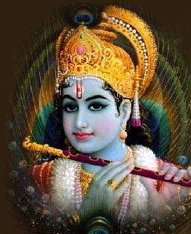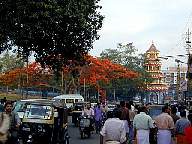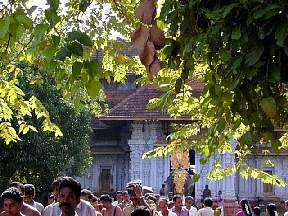 Origin of pilgrimage culture in Kerala.
Origin of pilgrimage culture in Kerala.In the medieval periods there were skirmishes between theologians mainly “Saivaites” (devotees of Lord Siva) and “Vaishnavaites” (devotees of Lord Vishnu) regarding the dominance of one deity over the other. It is in these circumstances the mythology regarding the origin of the Lord Ayyappa gained relevance.
The popularity of Lord Ayyappa grew as it was identified with both groups (the birth of Ayyappa is believed to have occurred by the merger of both Siva and Vishnu) acted as a commonly acceptable deity. The culture of going to pilgrimage to Sabarimala thus acted as a catalyst to evolving a trend of periodical pilgrimages. The Sabarimala pilgrimage season starts at the month of Vrichika (November – December)
Nalambalam pilgrimage is also gaining more and more popularity. (it is performed during the month of Karkitaka (July – August) It’s origin was at a time when vehicles were not available and pilgrimage to these four temples –as a ritual it had to be completed within one day between daybreak and noon- was an ardent task, yet devotees did it right out of their deep devotion. Great pains earned them great gains.
The first temple to be attended is the Thriprayar –where Lord Siva is the deity-see the “Nirmalyam” at 3 AM there, and proceed to Iringalakuda to attend the “usha pooja” at the Koodal Manikya temple where Bharathan –a rare deity in temples is installed, then “Utcha pooja at Moozhikkulam Lekshmana Perumal temple comes as the third, then the fourth and last temple at Payammal Shatrukhna temple to attend “Deeparadhana” there.
The completion of this blissful journey seeing four great temples all rich in history and interesting mythologies at a stretch and attending the poojas and rituals performed there will be an experience for the whole life. At this time when vehicles are popular even old people can perform it without much difficulty.
The mythology behind Nalambalam Pilgrimage
Bhagawan Sri Krishna had four favorite idols which he worshipped every day which are as follws.
- Lord Rama.
- Lord Lakshmana.
- Lord Bharatha.
- Lord Shathrukhna.
At the end of “Dwapara yuga” (in the Hindu mythology old time had been divided in to many yugas and Sri Krishna lived at the end of the Dwapara yuga) Sri Krishna knew that the end was near and directed Sri utthavan to install his favorite idols (mentioned above) in suitable places.
By the end of Dwapara yuga whole
The details of the temples where the idols were installed and the myths and specialties associated with them along with their locations are described one by one in the following article. This is also an invitation for devotees to perform the “nalambala theertha yatra” (pilgrimage to these four temples) and to experience a unique spiritual satisfaction.
Thriprayar temple at Thriprayar near Thrissur
The idol of Sree Rama was installed at this temple by the side of the river “Thivra” (Thiru purayar) meaning sacred river. The origin of the river is described in a beautiful mythology. Lord Mahavishnu during his “Vamana incarnation” visited this place and he found no water to wash his legs as the whole place was dry and desolate.
Vamana took the water from his “kamandalu” (a small round vessel used by sanyasis to carry water) and poured the water to wash his legs, that source of water never went dry but kept on flowing as the Thiru Purayar or the Thriprayar (river of divine source) as it is called now.
One mythology about the temple is related to “Naranathu Bhrandhan” the eccentric philosopher of the old Kerala myths. One stone used for temple rituals (balikallu) was always found loose and unstable. When Naranathu bhrandhan paid a visit to the temple the riddle was brought to him, the eccentric philosopher got it settled after performing special poojas. That stone is still available in the temple premises.
It is believed that the idols of the temple in the first time were not installed strictly as per the astrological rules and calculations. It is believed that Naranathu Bhranthan corrected the errors by installing the idols of Mother- Earth and Shree Bhagavathi at both sides of Sri Rama idol.
The Thrippayar temple does not celebrate a temple festival as in the case of other temples, even the other three temples where the idols brought by Kaimal celebrate festivals. There are five poojas and three “Sreebali” (sacrifice related rituals) performed in the temple.
The temple opens at 3 at the morning and remains open 12 at
The performing art “koothu” is very much associated with this temple. It is said that the once king Samoothiri visited this temple and watched this art and he expressed his wish to see the Hanuman’s mischieves in Lanka in detail. Thus the Koothu was extended to a twelve day performance. The Koothu performance starts on the first of Vrichika month.(November)
Koodalmanikyam
This is one of the most well known temples in Kerala built before the 15th century. It has uniqueness as the deity here is a prominent figure in the Ramayana mythology –Lord Bharatha.
As a temple with Lord Bhartha as deity is a rarity there are arguments that once this temple belonged to the Jains (Bharatheswara saint of Jains) and with the descent of Jainism this temple was taken over by Hindus.
There are beautiful mythologies regarding the origin of the name “Koodal Manikyam” one of them goes like this. The idol of this temple radiated magnificent light that excelled manikyam (a mythological precious stone believed to be kept and protected by divine serpents).
A manikyam kept in the
Curiosity turned out to be a nightmare as the manikyam vanished. The whole temple had to be handed over to the king of Kayamkulam as compensation. Due to the administrative difficulty the king of Kayamkulam handed over the right of the temple administration to one Thatchudaya Kaimal it was his family which handled the temple till 1971.
This temple has got much uniqueness. Once the ruling kings used to install granite slabs with his orders written, in this temple premises, the remnants of these stone slabs are still available.
The flowers used for pooja are as usual but thetchi (ixora) and thulasi (ocimum sanctum) etc not grown in the compound. Incense sticks and camphor are not used for the pooja. There are no (chuttambalam)sub deities in this temple.
The architecture used for the construction of this temple is typical Kerala style. The temple pond is also unique as but fish no other aquatic creatures are not available.
The deity of Koodalmanikyam is considered as the incarnation of “Dhanvanthari moorthi” The saint of healing. Hence many people approach this temple expecting cure of their ailments.
The deity of Lekshmana is also a rarity. It is situated at Moozhikulam between Alwaye and Mala. The mythology behind the name of this place goes like this. Once upon a time on the banks of river Poorna there an old Sanyasi by name Haritha Maharshi lived to undergo penance and meditation.
Lord Mahavishnu got impressed by the dedication of the yogi and appeared before him. That was the beginning of the “Kali yuga” (as per the Hindu calendar of all the yuagas Kaliyuga is the last one and that is present yuga in which we all are living) and the advices given by Mahavishnu were the ideal ways to lead life in this kali yuga.
These advices are said to be “thiru mozhi” meaning sacred words. And the place got its name as “thirumozhi kalam” –kalam meaning a stage. Later as years passed by thirumozhikalam became “Thirumoozhikulam”.
The Thirumoozhikualam Lekshmana Perumal temple had a superior status and it had a command over the other local temples. It attracted most of the Tamil Vaishnavite pilgrims who visited ancient Kerala. The temple had a bylaw by name “Moozhikulam katcha” which applied to all other temples of Kerala.
The “Periya Thiruvaymozhi” composed by the Tamil poet “Nammazhvar” praises the greatness of deity of Thirumoozhikulam. The deity of this
There are idols of Siva as dakshinamoorthi (south side) Ganapati, Sri Raman, Seetha, Hanuman Ayyappa and Bhagavathy in this temple. The idol of Sri Krishna (as goshala Krishnan)
There is an order in visiting the deities of this temple. Which is describes below, enter through the eastern gate and first visit and pray to the main deity Lakshmana, after praying there then visit Ganapathy, Siva and other deities then come back to Lakshmana to offer a second prayer after the pradikshana visit Ayyappa and Bhagavathy and then Krishna, and final visit to Lakshmana’s steps to offer prayers before returning.
The
The Payammal temple is about seven kilometers from Iringalakuda Koodalmanikya temple in the Iringalakuda Mathilakam route. Of the four idols retrieved from the sea by the fishermen this idol is the smallest. Shatrukhna is considered to be the reincarnation of the Sri Chakra in the hands of Mahavishnu.
During the period of Tippu Sultan this temple suffered severe damages but it was rebuilt by the joint efforts of the good people around it. By their initiative the temple festivals poojas and all other rituals restarted. Now it is working as a full fledged temple in all respects.
There are three poojas performed at this temple which opens for darshan early morning closes the door by ten O clock in the morning. The second session starts in the evening and remains open for darshan for “deeparadhana” and “Athazha pooja” and closes at
Sudharshana Pushpajali and submission of Sudharshana chakram offered at this temple are considered to boost the prosperity of the family members. The five days’ temple festival starts at Pooyam star of the month of Kumbha.(Feb.1 of 2007). The Ramayana month is celebrated with gaiety in the month of Karkitaka (between July and August.
Route Map for Nalambalam Pilgrimage





 when krishna is supposed to have told his foremost disciple Udhava to reinstall the idol of Lord Vishnu which he had installed at Dwaraka. The place was to be chosen by Guru Brihaspathi. Krishna promised Udhava that a true devotee can feel his presence in the idol. Collecting the idol from the submerged Dwaraka Brahaspathi and Vayu travelled all over India and with the help of Parasuram located a lake full of lotus flowers in Kerala. The lake was the abode of Lord Siva and Parvathi who moved to Mammiyoor for making place for Vishnu. As Guru and Vayu together installed and founded the temple, the place came to be known as Guruvayupuram. The lord is supposed to have chosen the image of little Krishna (Unnikrishna) at the temple of Guruvayoor. The sub deities worshiped are Ganapathi, Sastha and Bhagavathi. The four armed idol carrying Conch (Sanka), Discuss (Chakra), Mace (Gadha), Lotus niched out of a stone called "Pathala Anjanam" stand gracefully at the Sanctum Sanctorum as a manifestation of Almighty himself ever so merciful to ignorant multitudes.
when krishna is supposed to have told his foremost disciple Udhava to reinstall the idol of Lord Vishnu which he had installed at Dwaraka. The place was to be chosen by Guru Brihaspathi. Krishna promised Udhava that a true devotee can feel his presence in the idol. Collecting the idol from the submerged Dwaraka Brahaspathi and Vayu travelled all over India and with the help of Parasuram located a lake full of lotus flowers in Kerala. The lake was the abode of Lord Siva and Parvathi who moved to Mammiyoor for making place for Vishnu. As Guru and Vayu together installed and founded the temple, the place came to be known as Guruvayupuram. The lord is supposed to have chosen the image of little Krishna (Unnikrishna) at the temple of Guruvayoor. The sub deities worshiped are Ganapathi, Sastha and Bhagavathi. The four armed idol carrying Conch (Sanka), Discuss (Chakra), Mace (Gadha), Lotus niched out of a stone called "Pathala Anjanam" stand gracefully at the Sanctum Sanctorum as a manifestation of Almighty himself ever so merciful to ignorant multitudes. 











